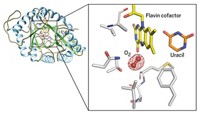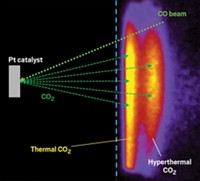Advertisement
Grab your lab coat. Let's get started
Welcome!
Welcome!
Create an account below to get 6 C&EN articles per month, receive newsletters and more - all free.
It seems this is your first time logging in online. Please enter the following information to continue.
As an ACS member you automatically get access to this site. All we need is few more details to create your reading experience.
Not you? Sign in with a different account.
Not you? Sign in with a different account.
ERROR 1
ERROR 1
ERROR 2
ERROR 2
ERROR 2
ERROR 2
ERROR 2
Password and Confirm password must match.
If you have an ACS member number, please enter it here so we can link this account to your membership. (optional)
ERROR 2
ACS values your privacy. By submitting your information, you are gaining access to C&EN and subscribing to our weekly newsletter. We use the information you provide to make your reading experience better, and we will never sell your data to third party members.
Biological Chemistry
Probing The Molecular Origins Of Mutagenicity
Environmental Pollutants: Researchers determine why two closely related airborne pollutants harbor divergent genotoxicity
by Steven C. Powell
June 28, 2010
| A version of this story appeared in
Volume 88, Issue 27

A pollutant in diesel exhaust, the potent carcinogen 3-nitrobenzanthrone (3-NBA), has a closely related structural cousin that often appears at higher concentrations in urban air. A new Chemical Research in Toxicology paper (DOI: 10.1021/tx100052d) explains why the structural similarity is only superficial: the isomer 2-nitrobenzanthrone (2-NBA) poses much lower risk because key enzymes in the human body do not readily metabolize it.
A variety of combustion processes create 3-NBA, which is part of the molecular mix on fine soot particles in diesel fumes. By contrast, 2-NBA is largely the product of a nitration reaction that happens spontaneously in the atmosphere. The parent molecule, benzanthrone, is common in urban air, so 2-NBA often approaches concentrations ten times higher than those of 3-NBA.
Because of 3-NBA's mutagenicity, high ambient concentrations of a structurally similar molecule worry scientists. But 2-NBA simply has not exhibited the same potency. In an assay involving a Salmonella bacterium, for example, Marie Stiborová, of Charles University in Prague, found that 3-NBA was some 2000 times more mutagenic than 2-NBA.
Stiborová's team sought to understand why. The researchers expected the isomers' differences in physical properties to be minimal given their structural similarity. So they instead focused on the interaction of 2- and 3-NBA with enzymes.
The team incubated each isomer with DNA and a variety of enzymes, and then used thin layer chromatography to determine the extent to which the DNA had been altered. Because 2-NBA did not form potentially harmful DNA adducts, the researchers determined that it is not a substrate for enzymes that activate 3-NBA toward DNA. In experiments with intact human liver cells, 3-NBA again generated DNA adducts, whereas 2-NBA did not.
The researchers then modeled the interaction between each isomer and the active site in the crystal structure of NAD(P)H:quinone oxidoreductase 1, which is the most productive enzyme in activating 3-NBA to create DNA adducts. This molecular docking study shows that a key hydride transfer from the enzyme to the pollutant's nitro group would have to occur over a larger distance with 2-NBA than with 3-NBA.
Takeji Takamura-Enya, of the Kanagawa Institute of Technology, in Japan, who first identified 3-NBA's powerful mutagenicity, welcomes the contribution. "Unfortunately, research on this new group of mutagens—the nitro-aromatic ketones—had previously not been going well because of analytical difficulties," he says. "It's essential that we elucidate the hazards posed to humans by the toxic compound 3-NBA and its structural relatives as quickly and as thoroughly as possible."





Join the conversation
Contact the reporter
Submit a Letter to the Editor for publication
Engage with us on Twitter